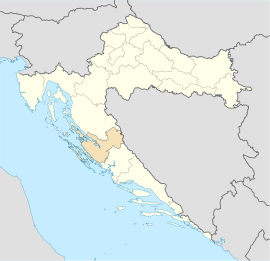Savar (Croatia)
| Savar (Croatia) | ||
|
|
||
| Basic data | ||
|---|---|---|
| State : |
|
|
| County : |
|
|
| Island : | Dugi Otok | |
| Municipality : | Sali | |
| Height : | 62 m. i. J. | |
| Residents : | 76 (2011) | |
| Telephone code : | (+385) 023 | |
| Postal code : | 23282 | |
| License plate : | ZD | |
Savar (Italian: Sauro) is a village on the island of Dugi Otok in Croatia .
Location and inhabitants
Savar is located almost exactly in the middle of the island between the villages of Brbinj and Luka opposite the island of Iž . In 2011 the village had 53 inhabitants who live from simple agriculture, fishing and tourism. Savar is also known for the use of the native stone that was used in the construction of the forum in Zadar , palaces and churches in Rome and Venice and the UN building in New York.
| Population development | |||||||||||||||
|---|---|---|---|---|---|---|---|---|---|---|---|---|---|---|---|
| 1857 | 1869 | 1880 | 1890 | 1900 | 1910 | 1921 | 1931 | 1948 | 1953 | 1961 | 1971 | 1981 | 1991 | 2001 | 2011 |
| 151 | 167 | 178 | 177 | 202 | 242 | 284 | 298 | 286 | 282 | 197 | 188 | 93 | 85 | 57 | 53 |
history
Savar was first mentioned in 1279. According to the Croatian linguist Petar Skok , the name comes from the Greek Szaurosz (lizard). The Italian sauro was used later .
The pre-Romanesque church of Sveti Pelegrin (13th century) is located on a small island that has been connected to the mainland by a dam. The presbytery is actually a pre-Romanesque church, the nave and the sacristy were later modernized. The baroque baptistery with Glagolitic inscriptions was transferred to the parish church from 1670. It is one of the most important ancient Croatian sacred buildings.
The area of the village, like the rest of the island, belonged to Zadar and became part of the Venetian Republic together with the city from 1409 . At the end of the 18th century, Napoleon abolished the Venetian Republic. Between 1797 and 1805 Dugi Otok came under the rule of the Habsburgs and then became part of the French Empire along with all of Dalmatia. In 1815 it was again handed over to Austria by the Congress of Vienna, which administered it from Zara as part of the Kingdom of Dalmatia until 1918.
The monastery of the hermit Sveti Antonius in Savar was destroyed and abandoned in 1505. Small parts of the ruin are still preserved today.
The Strašna peć (Terrible Oven) cave is located near the village of Savar in the central part of Dugi Otok . This was first published in 1898 in the Zadar newspaper Il Dalmata in an article by Dr. Luka Jelic mentioned and was made popular in 1904 by the "Illustrierte Austrian Riviera Zeitung". From then on, the cave attracted numerous tourists. The Austro-Hungarian Emperor Franz Joseph also visits the cave. Access stairs and a veranda were built. The entrance is 70 m above sea level and was closed with an iron gate. It has been open to tourists again since 2007.
During the Second World War, between May 7 and 13, 1943, the Italian occupation forces burned the entire settlement down, killed its population or deported them to concentration camps. Because of this, almost all of the buildings in the village that can be seen today were built after the war. The sharp decline in population was not due to this war, but to the emigration to America, Sinai and Australia that began after the war.

